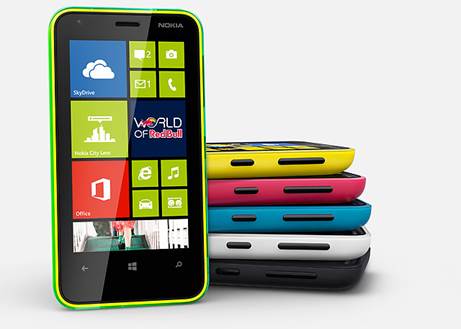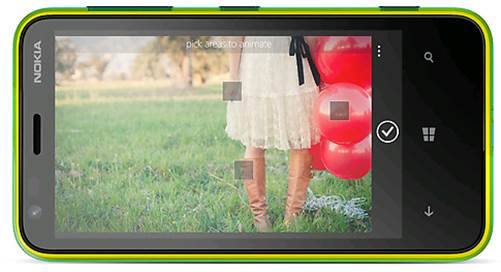Lumia 620 is so far Nokia's cheapest Windows
Phone 8 device. It's a device that might never show up in the US, due to a very
attractive price (234 USD, or about 368 USD), unless American network providers
are willing to reduce the price from the beginning. But it's a surprisingly
attractive Lumia - in fact it's hard to put it in the same category as Nokia's
previous cheaper Windows Phone options. Those colors hit you right into your
eyes, with matte and gloss covers in cyan, lime, yellow and magenta presenting
an exciting option apart from the more level-headed black and white versions.
Behind that shell, a 1GHz Snapdragon S4 Plus microprocessor is running, with a bright
3.8-inch ClearBlack display with an 800x480 resolution.

Lumia
620 is so far Nokia's cheapest Windows Phone 8 device.
Despite the price, it's running the latest
iteration of Windows Phone 8 and Nokia also ensures its own camera lens apps,
along with its music and mapping services, all have been carried over. The
5-megapixel camera may be beaten by Zeiss-equipped 8-megapixel sensors on its elder
brothers, but with a 468-USD difference between Lumia 620 and Lumia 920, what
other sacrifices have been made? Is this the best value-for-money-equation
Windows Phone we've ever seen? We think it might be.
Hardware
After trying both Lumia 920 and Lumia 820,
it's a fortunate to see Nokia's phone look shrink so that it's closer to 2011's
Lumia 800. The 620 model has a slightly larger screen than that polycarbonate-inlaid
phone, but it feels equally comfortable in our hands - one-handed use is not an
issue. While the screen's surface is completely flat, the edges curve around
gently, forming a rounded back.
The entire cover can be prized up by
pressing down on the camera unit and pulling the top edge of the cover. Does it
feel as plastic as the Lumia 610? No. Shaky? A little - there's a bit of
resilience in the center of the back, but the cover and device feel unified and
sturdy. Better than all, owing to the way the covers are formed (two different
color layers, such as orange and lime-green) they've very vivid colors - the light
cyan cover is this editor's favorite. The case can also be damaged quite much if
drops, with the easily breakable headphone port attach to each case instead of
the phone itself.
Nokia has added a front VGA camera to this
model (the first one for a basic Nokia Windows Phone), while a 5-megapixel
sensor and flash are centered on the back. For fans of Lumia series, the front
is even more familiar. The screen is framed with about 2mm of bezel at 2 sides,
with space above it for the VGA camera and earpiece mentioned before. Below the
TFT screen, you'll find the basic three-button capacitive control panel.

Nokia
has added a front VGA camera to this model (the first one for a basic Nokia
Windows Phone), while a 5-megapixel sensor and flash are centered on the back.
Along the right edge, there's still a hard
camera button - and all the buttons seem to be more resilient than Nokia
devices from last year. The micro-USB port sits along the bottom with the main
microphone, while the headphone is on the top, along with a second mic. It's
worth noticing that Lumia 620 has the high-amplitude, distortion-free mics immersed
inside Lumia 920. Meanwhile Lumia 620's built-in speaker seems to be 20dB
louder than Nokia's leading phone, which is able to go through thin walls at a
maximum of 100dB.
If you want your music to be louder, the
phone is also compatible with JBL's wireless speakers through the pre-installed
NFC, while a removable 1300mAh battery locates next to the space for a microSD
card. You’ve already had 8GB of built-in storage from the beginning, while
Microsoft is still providing 7GB of cloud storage through SkyDrive - in short,
there are many storage options. Just 512MB of RAM, but that's pretty much for
handling the current apps on Windows Phone - we don't have any problem using
Skype or other apps, although we can't verify how future-ready this phone will
be, compared to Windows Phone devices having 1GB of RAM.
The device won’t make pockets saggy with
127g, but it's not the most slender phone now. At 11mm (0.43 inch), it's
actually thicker than Lumia 920, but with this smaller shape factor, you won't
have any problem with one-handed control. Nokia's new phone is more comfortable
to use, even if that means there's less screen to play with.
Screen
If you’re looking for a Windows Phone 8
device under 4 inches, options are pretty limited. But here, you're getting a
display that's suitable for the price: a 3.8-inch touchscreen that goes well
with the resolution of most Windows Phones which means 800x480. Nokia's
included ClearBlack technology and an RGB Stripe pixel arrangement, while
adding an anti-glare layer to improve outdoor visibility. Compare it to Lumia
820, it requires a bit more explanations.

Considering
in 1 way, the 620's screen looks better – it has the same number of pixels in a
smaller space, but it's no longer AMOLED screen.
Considering in 1 way, the 620's screen
looks better – it has the same number of pixels in a smaller space, but it's no
longer AMOLED screen. Colors seems slightly more muted on the 3.8-inch TFT if
compare, although it also lacks AMOLED's green color in white areas. At this
time, after playing with 4.7-inch screens you might think that smaller screens
would make web browsing a little more frustrating, but page formatting is still
identical among the three Windows Phone 8 Lumia phones.
Camera
If there is one feature that we consider to
be unimpressed, that is the camera. Despite the fact that Nokia spins a long
yarn about the ability of the optical image stabilization and Carl Zeiss lens,
you won't find either here. Maximum image resolution falls to 5 megapixels, but
the sensor is still capable of having 720p-capture ability, with an LED flash
strong enough to light up your subject - it's possibly a little too strong for
close-up shots. The physical button sets the camera running almost immediately,
with no lag as its predecessor, and with the same ability to lock focus with a
half-press. We find that in most situations, tapping the screen to focus is
better.
The camera is able to take a plenty of nice
photos, although focus seems to be quite more erratic than on other Windows
Phones we tested last year. It still manages to give us some acceptable results
in less optimal conditions, but if we are planning for a close-up shot in
better light settings, that decreased resolution delivers results that are not
so detailed. That is to say, there's not much noise we've seen from other
smartphone cameras under 312 USD we've tested in the past 12 months - we're
pointing directly at some of ZTE's and Huawei's cheap specific models for
network providers.

If
there is one feature that we consider to be unimpressed, that is the camera.
Unfortunately, there are still the same
complaints that we mention in most Windows Phone reviews: there's no HDR mode,
UI itself is has a few customizations and there's no way to lock exposure to
avoid exploding your images in bright light condition. However, Panorama mode
and Nokia's GIF-crafting Cinema graph are worth installing because they add
some extra capabilities to the camera.
Prefer video? Lumia 620 also has a decent
performance here. There's no optical image stabilization, but that is still an
extremely rare addition to phone cameras. While a bit of wind hit the mics, it
recorded our voice (and some waterfowl sounds) with perfect clarity.